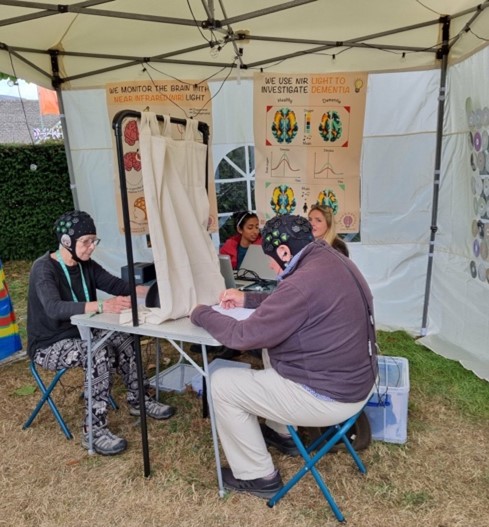Submitted by Sruthi Srinivasan on Fri, 21/04/2023 - 14:42
Our lab worked with musicologists Professor Jennifer MacRitchie and Professor Renee Timmers from the University of Sheffield, and Dr Ming Hsu from Anglia Ruskin University to try to answer this question. PhD students Emilia Butters (a neuroscientist) and Sruthi Srinivasan (an electrical engineer) created an experiment, using a CAPE Acorn award, which combined state-of-the art brain scanning technology with machine learning to unravel the link between music and memory. Our lab is very enthusiastic about public engagement and we wanted to carry out this study somewhere where we knew we could reach a lot of people and demonstrate how our technology can be used in unusual testing settings, such as a field! The science festival (‘Einstein’s Garden’) at the Green Man music festival 2022 was the perfect setting for this study. Thanks to those who took part, we were able to test a total of 160 people over 4 days!
In this experiment, people first listened to excerpts of happy and sad music alone, and then listened with another person. This allowed us to investigate two important questions:
-
Does the type of music (e.g., happy or sad) influence the brain responses to music?
-
Does the social setting (e.g., listening alone or with someone else) influence brain responses to music?
We recorded brain activation using the LUMO device (Gowerlabs Ltd). This is a high-density near-infrared spectroscopy device which measures changes in the levels of oxygenated and deoxygenated blood. When a brain area is active, for example the auditory cortex (the part of the brain responsible for processing sounds), the brain cells require nutrients and oxygen in order to function. There will be a massive increase in oxygenated blood to that area to provide those cells with the nutrients they need. We therefore assume that areas showing increases in oxygenated blood are active and can use this technique to look at brain activity.
Some preliminary results
The below figure shows the responses to happy music averaged across participants, with responses when people were listening to the music alone on the left, and responses when people were listening to music with someone else on the right. On these scans, the blue colour means there is decreased amounts of oxygenated blood, whereas the red colour means there is increased amounts.
We expected that listening to music with someone else would cause more brain activity (higher changes in the level of oxygenated blood) compared to the solo condition. We were surprised to see the opposite! When people listened to music with others, they had less activation on average. This may have something to do with the pattern of activation instead. We can see that listening alone and listening together causes brain activity in different brain areas which may be related to social interaction. This might be because people are more focused on the music itself when listening alone, but when listening with someone else, people may shift their attention to the other person and pay less attention to the music.
We still have a long way to go with the analysis to understand exactly what these different patterns of brain activity mean and how they might help us understand the effects of music therapy. Please keep an eye on our website for more updates as to how this research is progressing and any papers we may publish!
References
- Moreno-Morales et al. (2020). Music Therapy in the Treatment of Dementia: A Systematic Review and Meta-Analysis. Front Med. 7:160. Doi: 10.3389/fmed.2020.00160.
- Schlaug. (2015). Musicians and music making as a model for the study of brain plasticity. Prog Brain Res. 217:37-55. Doi: 10.1016/bs.pbr.2014.11.020.


